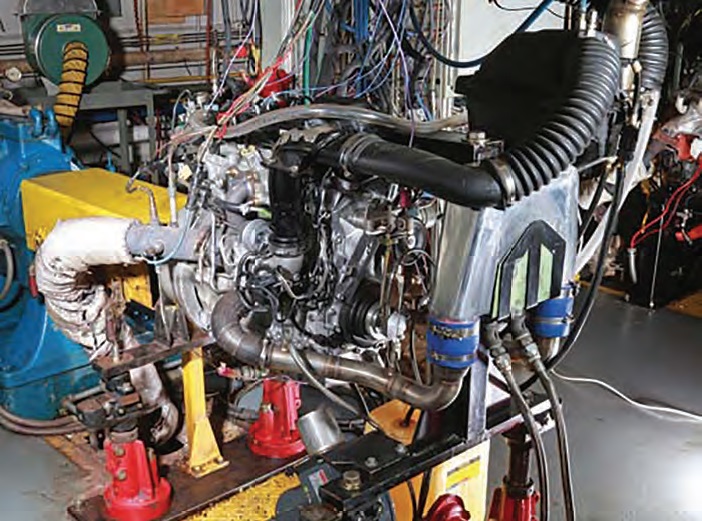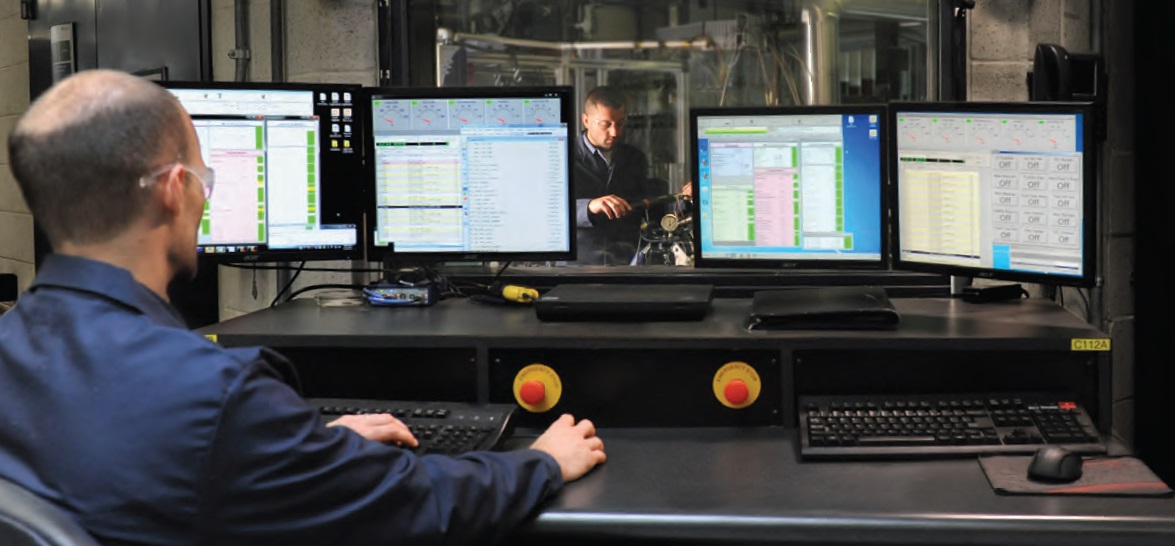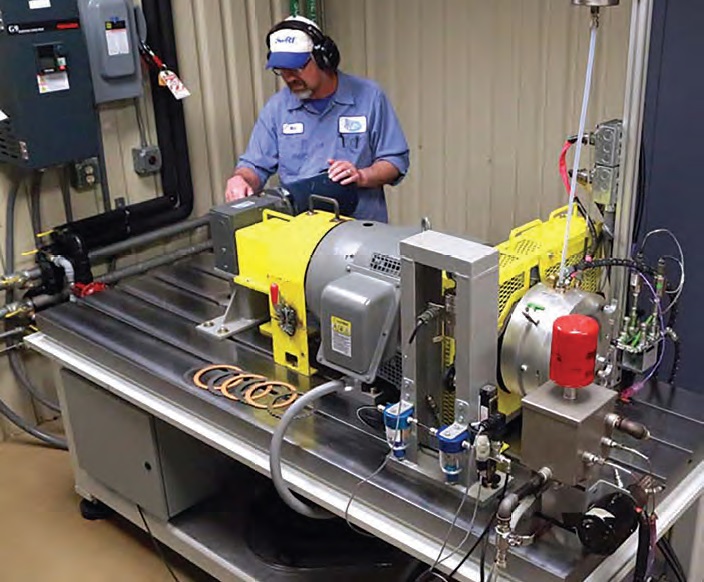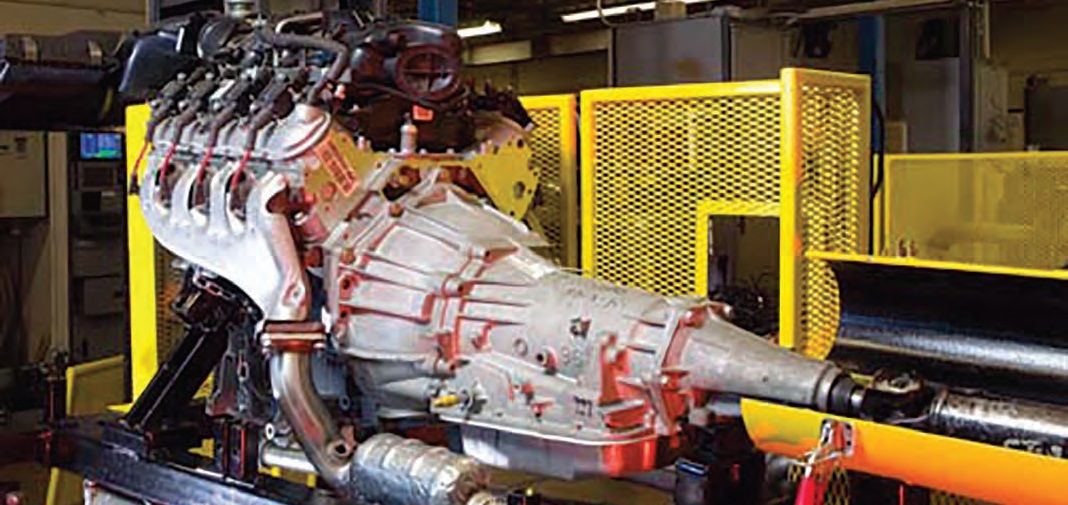Developing engine and drivetrain tests
Jeanna Van Rensselar, Senior Feature Writer | TLT Best Practices May 2020
New testing hardware on vehicles and engines are helping OEMs to meet fuel economy and emissions requirements.

Sequence IX, Low-Speed Pre-Ignition Engine Test Stand (Courtesy of Southwest Research Institute)
KEY CONCEPTS
• Increasing demands placed on lubricants by newer engine designs and fill-for-life/ extended drain interval fluids make test accuracy more important than ever.
• Test requirements and procedures for engine and driveline lubricants are different.
• The cost of developing new lubricant evaluation test methods can run into the millions.
The drivers for the successful development of effective computer-controlled test stands are consistency, cost control, data quality and process control. The control of test parameters is better—data can be accessed 24/7 remotely and there is the assurance that lubricants sold have been rigorously tested in a consistent manner. While these tests have significantly improved repeatability, there are issues such as who pays for the cost of test development, which can run into the millions.
According to Andrew Ritchie, senior industry liaison advisor with Infineum, there are many reasons that lubricants, especially the new lighter viscosity grades, need thorough testing.
“They do enable improved fuel efficiency but must be able to protect OEM equipment by addressing a wide range of challenges, which go well beyond ensuring against catastrophic wear, due to therubbing of moving parts,” Ritchie explains. Among the areas of concern Ritchie cites are cold-start capabilities, water handling and protection against sludge, oxidation, rust, aeration, pre-ignition and deposits.
Ritchie says that since the lubricant is a key vehicle component, there needs to be some assurance that it will meet the performance needs of both the engine and emissions protection system. “The concern we are seeing currently is tied to the ability to develop and maintain performance tests that are field-relevant and able to measure the lubricant’s ability to do this,” Ritchie says.
Bob Campbell is senior manager, R&D Engineering and Applied Statistics for Afton Chemical Corp. The fact that he has been in the oil industry for over 30 years has given him a unique perspective. “When I started, the industry was beginning to transition from manually-controlled test stands (think manual gate valves, boat throttles, gauges, and strip charts) to fully automated controllers and data acquisition systems,” he explains. “This change has not only improved test precision from an operational perspective but also a data analysis perspective. Now that we have data automatically generated, it’s much easier to mine for differences, correlations, and ultimately impacts on test results. I also think we learn as we go, so areas we improved upon years ago became second nature during more recent test developments, which, by its very nature, improves precision.”
Campbell agrees with Ritchie that demanding requirements for newer vehicles makes precise lubricant testing more crucial than ever—and OEMs must play a role.
“Vehicles and engines are becoming much more sophisticated to meet the stringent fuel economy and emissions requirements placed on OEMs,” Campbell says. “This sophistication, however, makes testing more challenging. For stationary vehicle and engine testing, we need much less sophistication, or less ECU input, allowing our control systems full access to the hardware. OEM support becomes crucial to help identify and recalibrate away from these ECU-controlled inputs, thus allowing our test stands to control all aspects associated with engine or vehicle operation and ultimately improve test precision.”
Campbell adds, “Newer engine designs are also impacting current and future test developments. OEMs have done a tremendous job engineering their hardware to perform in the field for hundreds of thousands of miles, and largely have engineered wear out of today’s engines. This improvement makes it increasingly difficult to design engine tests that can identify an oil’s ability to discriminate on wear and puts a further premium on precision.”
Differences between driveline and engine lubricants
Driveline lubricants are generally gear oils (for axles) and transmission fluids. STLE-member Cole Hudson, research engineer for Southwest Research Institute, is a driveline expert. Much of the same information that applies to the testing of engine lubricants also applies to driveline lubricants, but there are differences.
“In the technology sector I work in, many driveline lubricants are fill-for-life or have extended drain intervals relative to engine oils,” Hudson explains. “This means that end-of-life performance of driveline lubricants is an important consideration in current driveline testing methods and specifications. While a typical ASTM passenger car motor oil test may run for 100- 200 hours, many driveline fluid endurance tests will run for 300-600 hours and many properties tests are performed on new and aged fluid.”
Hudson says that the most apparent difference between engine and driveline lubricant testing requirements is the consideration of friction properties of transmission fluids. In an automatic transmission, the fluid and its additive package need to (among other things) control gear wear and corrosion, maintain compatibility with seal materials, limit foaming and contamination, prevent oxidation, cool the transmission components, and deal with the competing constraint of maintaining friction performance in the wet-clutch friction interfaces found in modern transmissions. A large portion of current automatic transmission fluid (ATF) specifications is dedicated to listing constraints for holding torque, anti-shudder (stick/slip) performance, and shift “feel” for both new and aged fluids.

Collaboration and communications between engineers and scientists throughout the test development process is the key to success. (Courtesy of Bob Campbell, Afton Chemical Corp.)
Challenges
Campbell reminds that engine tests need to be repeatable and reproducible because they are used by formulators to evaluate engine oil packages for both component research and package approvals. He goes on to list and expand on some of the items that can impact engine test repeatability and reproducibility, which can be classified into the following categories: test development, build, operation, environment, and hardware and fuel.
• Test development. Test repeatability begins at the inception of the test development process. Before initiating test development, it is imperative to develop a fundamental understanding of the parameter or region within the test hardware that is in question. Without a full understanding of the mechanisms and chemistries involved (i.e., corrosive versus abrasive wear), test precision will likely be compromised. This could also impact development timing, behaviors or responses within the formulation space, and ultimately not provide the intended results in the field.
• Build and operation. Afton Chemical Corp., along with other labs operating ASTM standardized tests, follows the prescribed ASTM procedures that indicate how engines are built. It’s the ASTM surveillance panel’s responsibility to ensure the procedure is comprehensive enough to capture all required aspects. However, sometimes there are areas that are missed. These areas can often impact repeatability and reproducibility if personnel, within a lab or across labs, approach them differently. It is crucial for these items to be identified and standardized within the panel to achieve better test precision.
• Environment. On occasion, tests can be impacted by environmental changes. Barometer, humidity, temperature, cleanliness, and airflow can often impact test results. To the extent possible, these impacts need to be engineered out via the test procedure.
• Hardware and fuel. These are two of the largest levers that can impact repeatability and reproducibility. Test parts are identified as either “critical” or “non-critical.” The premise is that critical parts can impact test results, and because of this, need to be controlled via a batch process. The industry does a relatively good job of acquiring large batches, but occasionally batch-to-batch variation or even within-batch variation is larger than they would like. Batch-to-batch variation can usually be identified early and handled via either batch elimination (if the hardware is deemed unfit) or a mathematical correction if they prove adequate but statistically different. Within-batch variation is more difficult to handle and is generally “baked in” to the final test precision. The surveillance panels, OEMs and hardware suppliers are often asked to supply hardware within tighter tolerances than production to minimize this impact. In engine oil testing, fuel is generally identified as critical, requiring all labs and stands for a particular test type to operate on the same fuel from the same supplier.
In engine oil testing, fuel is generally identified as critical, requiring all labs and stands for a particular test type to operate on the same fuel from the same supplier. In some cases where batch-to-batch variation is known to be a test severity or precision lever, very large batches are requested to eliminate potential impacts. In other cases, batches are smaller but still have the potential to impact test results ever-so-slightly. In these cases, the surveillance panels on occasion will analyze the data to determine if impacts exist, and, if so, what potential paths exist to help minimize or eliminate the effects.
“It’s our job to either control or eliminate as many of these variables as possible,” Campbell concludes.

SAE No. 2 Clutch Friction Testing Stand (Courtesy of Southwest Research Institute)
Accuracy/repeatability
For Infineum, as an additive company, one of the largest concerns with repeatability of engine tests lies with controlling the critical parts, as well as any variations in test procedures between test laboratories. Collaboration and communications between the engineers and scientists throughout the test development process, using the frameworks provided by the industry technical groups, is often the key to success.
Infineum’s Ritchie says, “Maintaining the test is also a key concern— understanding the needs of all the specifications using the test, assuring that the critical parts and fuel are available in sufficient amounts and are of the required quality for the estimated life of the test. Utilizing some forms of the new digitalization tools available may allow for better control of these parameters throughout the life of the tests.”
From Ritchie’s perspective, ideally the test is monitored by an official body and the operational data is continuously collected and stored so that it can be monitored and charted. In North America, the ASTM groups continuously perform this function, monitored carefully by the ASTM Test Monitoring Centre (TMC).
“Reference oils are important since they allow test result data to be collected over the life of the test and variations in final results for the key parameters to be continuously monitored,” Ritchie says. “Since the severity and precision of a test are always at risk to drift, the continuous monitoring and charting of all the data is essential.”
Afton Chemical’s Campbell emphasizes, “To maintain and improve test repeatability and reproducibility, it’s absolutely in the details.”
When compared with engine oil testing, automatic transmission fluid testing, with a few exceptions, is typically further removed from the actual OEM hardware. “An engine oil test will use a complete, running engine, and run durability length cycles at low DAQ rates. Test metrics are evaluated at the end of the test based on examination of the parts or used oil analysis,” Hudson says.
Automatic transmission fluid tests are usually component-level, using non-original equipment parts in a purpose-built test stand (i.e., a single clutch plate in an SAE No. 2 machine or a pump in a test rig). The rigs are designed to drill a bit deeper into the fluid properties, isolating a single fluid stressor and measuring the fluid’s response in a single area. “Because the stands rely on less original equipment, they will be less sensitive to changes in parts, whereas engine tests are extremely sensitive to small changes in supplied test parts,” Hudson explains.
Test development
Infineum’s Ritchie believes that the current test development process is unsustainable.The answer, Ritchie says, is for stakeholders to pool their limited funds and expertise and apply improved rigor in the processes. “Defining and developing these new tests is the key to defining the specifications of the near future,” he says. “Currently, the gasoline and diesel engine oil stakeholders are working with the PCMO and HDD OEMs through API to deliver improvements to the current test development process. We believe that working together as an industry to enhance the current process will maximize the use of limited funds and resources, as well as introduce the principles of project management to provide a sustainable process for the future.”
Heavy-duty engine oil (HDEO) API CK-4/FA-4 tests for diesel
• Caterpillar 1R Lubricant Test
• Caterpillar 1K Lubricant Test
• Caterpillar 1M-PC Lubricant Test
• Caterpillar 1N Lubricant Test
• Caterpillar 1P Lubricant Test
• Caterpillar C13 Lubricant Test
• Cummins ISB Lubricant Test
• Cummins ISM Lubricant Test
• Engine Oil Aeration Test (EOAT)
• Caterpillar Oil Aeration Test (COAT)
• DD13 Scuffing Test
• Roller Follower Wear Test (RFWT)
• Mack T8/T8A/T8E Lubricant Test
• Mack T11 Lubricant Test
• Mack T12 Lubricant Test
• Mack T13 Lubricant Test
GF-5/GF-6 ASTM tests for gasoline
• Sequence IIIH (ASTM D8111)
• Sequence IVA (ASTM D6891)
• Sequence IVB (ASTM TBD)
• Sequence VH (ASTM TBD)
• Sequence VIE (ASTM TBD)
• Sequence VIF (ASTM TBD)
• Sequence VIII (ASTM D6709)
• Sequence IX LSPI test
• Sequence X chain wear test
Note that GF-6 takes effect May2020.
Drivetrain fluid tests (offered at SwRI)
• FZG gear wear test (ASTM D 4998)
• FZG load stage test (ASTM D 5182 and CEC L-07-95)
• FZG pitting test with Type C gear
• FZG step load (A10/16.6R/90:120, CEC L-84-02)
• FZG standard wear test
• FZG FVA54 micropitting test
• L-20 high-torque test
• L-33-1 moisture corrosion test (ASTM D 7038)
• L-37 high-torque test (ASTM D 6121)
• L-42 high-speed shock axle test (ASTM D7452)
• L-60-1 thermal and oxidative stability test (ASTM D 5704)
• Manual transmission high-temperature cyclic
durability test (ASTM D 5579)
• SSP 180 synchronizer
• Dexron 6-Speed Transmission Cycling Test
• Dexron 4-Speed Transmission Cycling Test
Friction tests (offered at SwRI)
General Motors
• Plate Clutch Friction
• Low Speed Clutch Friction & Torque Capacity
• Anti-Shudder Durability
• 3 Day Wear Test
Allison
• TES 389 Frictional Properties
• TES 439 Graphite High Energy Friction
Ford
• Anti Shuder Durability
• Clutch Friction Durability
• μ-V Characterization
Caterpillar
• TO-4 or TO-4M Friction Properties
JASO
• T903:2016 Clutch Friction
SAE
• J2487 Stepped Power Test
• J2490 μ-PVT Test

DEXRON-VI® Transmission Cycling Test Stand (Courtesy of Southwest Research Institute)
OEM specifications
As with engine lubricants, the initial requirements are put forth by OEMs. From there, things are very different between engine and driveline lubricants, and even between different types of driveline lubricants.
Hudson explains that the process for creating an engine oil specification is prescribed, as an industry effort, and conducted at semi-regular intervals. Ideally major OEMs, oil and additive companies, and laboratories will collectively fund and cooperate on development of test methods and specifications. A standards body will govern the meetings and maintain the fully developed test methods. Another independent organization will then control specification approvals, track industry severity and monitor entry of new test stands and laboratories into the market. This is not the case with all driveline lubricants.
“For the most part, general-purpose axle lubricants are similar,” Hudson says. “Other driveline fluids’ specifications are more varied with most OEMs or hardware manufacturers publishing their own specifications and creating their own approval processes. These specifications may include methods from standards bodies but are often made entirely of methods unique to that specification, developed partially by the OEM or even borrowed methods from other specifications. The funding of driveline fluid test development, similar to the specification development, is provided on a case-by-case basis.”
Cost
Ritchie explains that lubricant qualification costs for a large program are in the millions of dollars once all the customer base stock and viscosity grades have been addressed. For a major API category, like API CK-4 and ILSAC GF-6/API SP-RC, the development and approval costs to cover all the markets may be more than $100 million for each major additive supplier.
“While the costs may be partially split between the main stakeholders, the majority of the cost is shouldered by the additive companies,” Ritchie explains. “Oil marketers and base oil suppliers may supplement the cost of specific programs.”
Ritchie continues, “The cost of test development is dependent on the origin of the test and, in recent years, many different funding paths have been adopted. Some tests are developed exclusively by OEMs, in partnerships between OEMs and lubricant marketers and/or additive companies, while others may be developed by industry groups such as an OEM leading a task force or an industry group organized, for example, through ASTM. In these cases, the funding comes from numerous participants, which also include the test laboratories and critical parts and fuel suppliers. In North America, the precision matrix necessary to assess the adequacy of the test to measure the performance required in the specification, and the base oil and viscosity grade read-across matrices, have been co-funded by the API, ASTM and OEM trade associations.”
Campbell believes that test development and maintenance is a delicate balance of time, money and resources. “We need to always ensure the balance is appropriate and doesn’t become dilute with either too many developments, too little time, or not enough money for proper development,” he concludes. “Any one of these three can negatively impact test precision and the ability to properly discriminate fluids. More importantly, we could end up with a test that doesn’t discriminate on the intended parameter, adds no ultimate value to the end-user or that actually creates a future unknown problem.”
Jeanna Van Rensselar heads her own communications/public relations firm, Smart PR Communications in Naperville, Ill. You can reach her at jeanna@smartprcommunications.com.